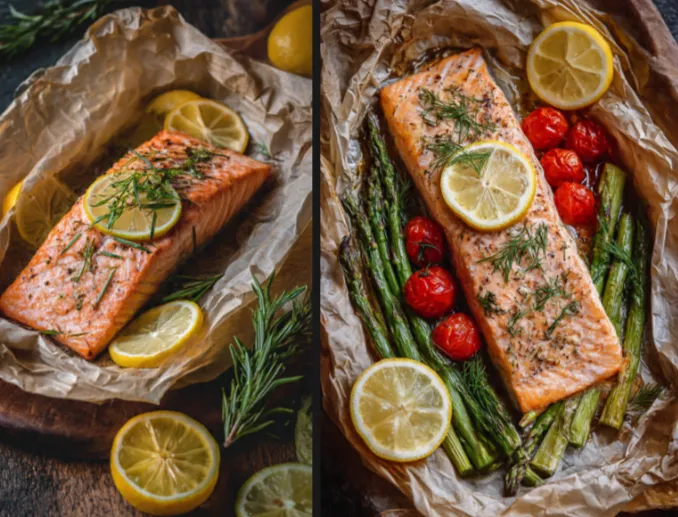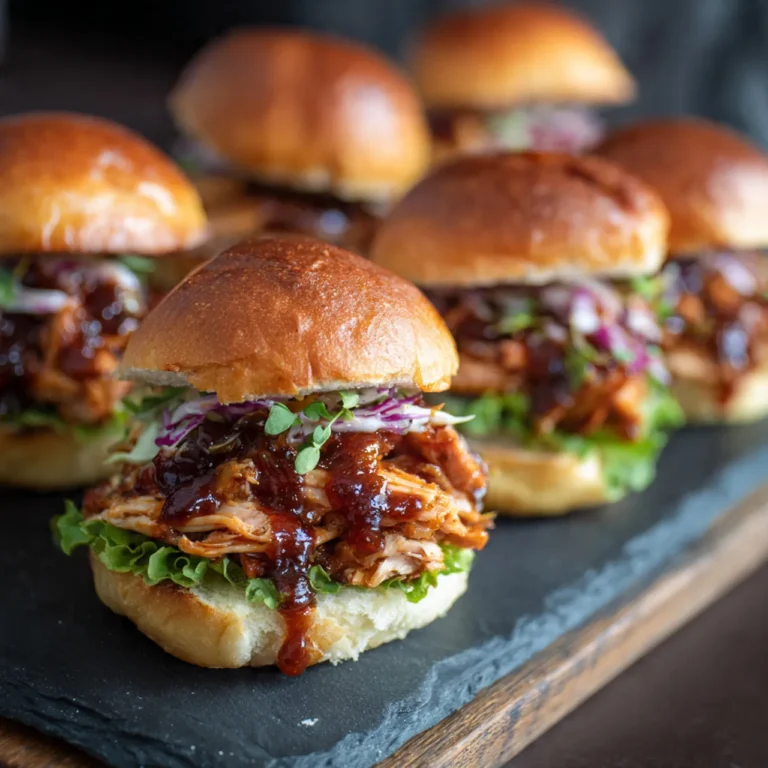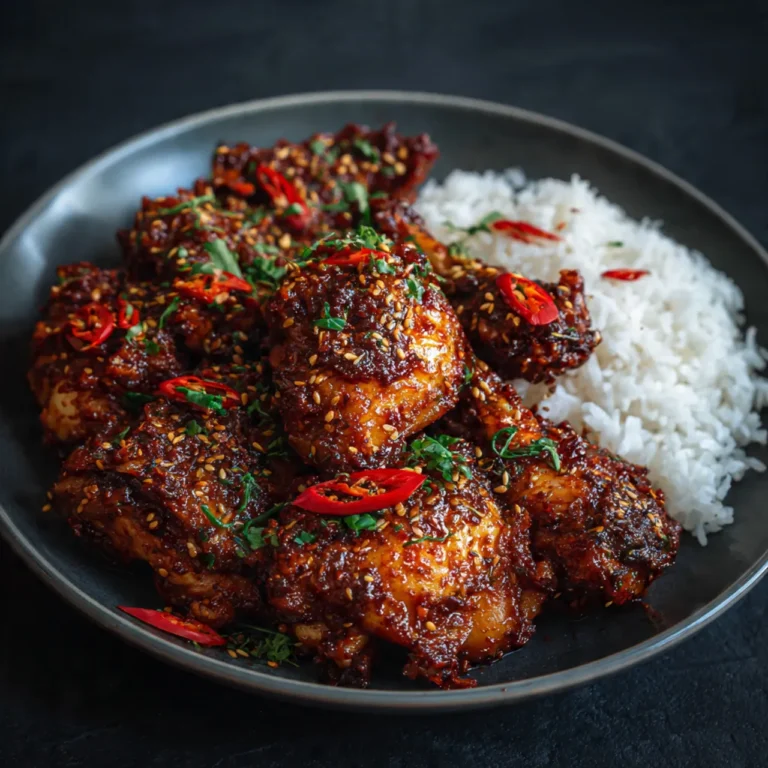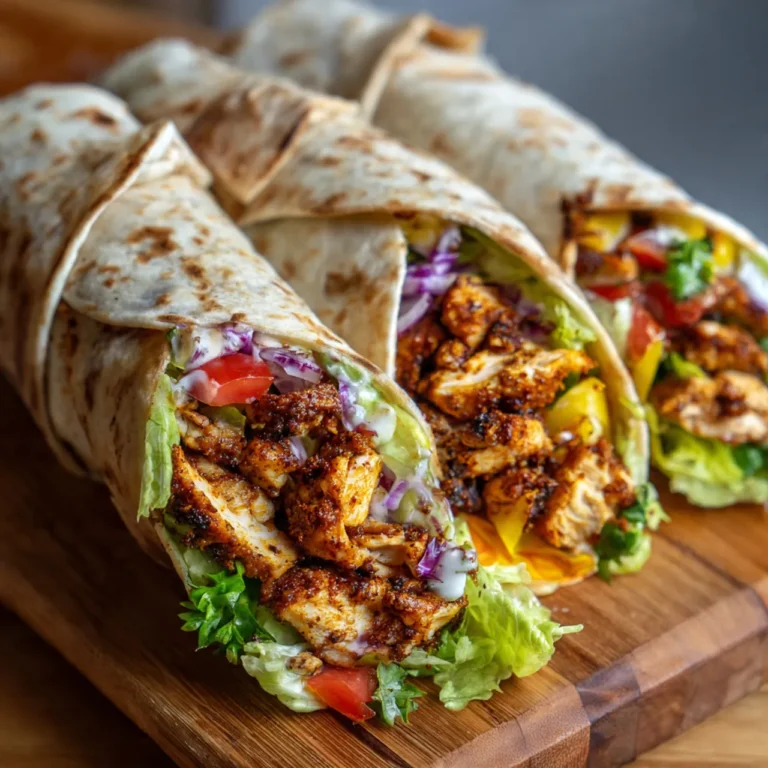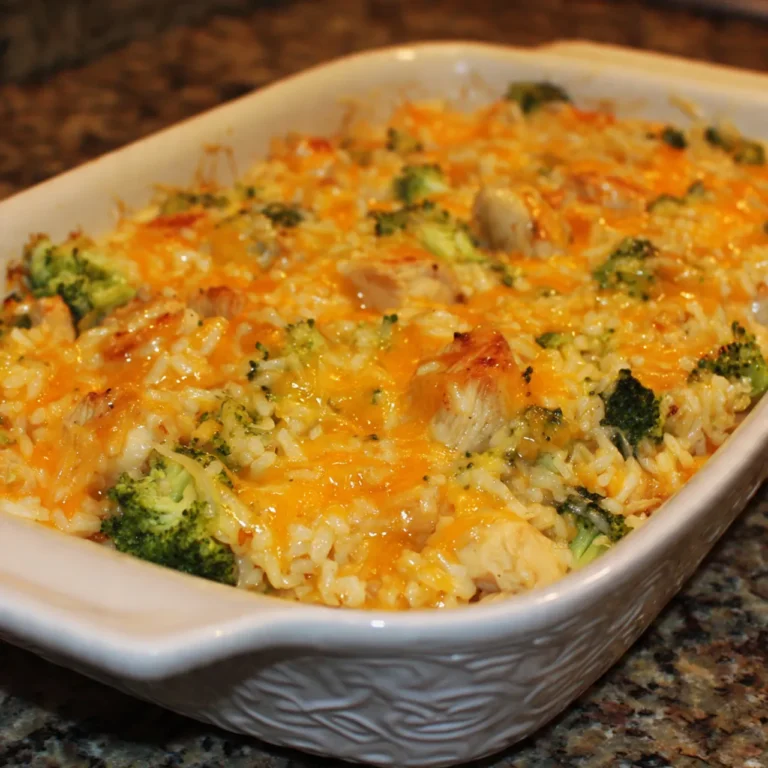Salmon en papillote, or salmon baked in parchment, is a classic French cooking technique that delivers tender, flavorful fish with minimal effort. The salmon is sealed in a parchment paper packet along with vegetables, herbs, and a splash of liquid, then baked until perfectly steamed in its own juices. The result is a dish that’s light, aromatic, and incredibly satisfying.
This method of cooking is as elegant as it is practical. The parchment traps steam, gently cooking the salmon while infusing it with the flavors of lemon, herbs, and vegetables. When the packet is opened at the table, a burst of fragrant steam escapes, revealing a perfectly cooked piece of fish surrounded by colorful accompaniments.
Salmon en papillote is ideal for both everyday meals and special occasions. It’s healthy, visually stunning, and surprisingly easy to prepare.
The Essence of Salmon en Papillote
The term “en papillote” means “in parchment” in French. This technique involves wrapping food in parchment paper (or sometimes foil) and baking it so that it steams in its own moisture. The result is tender, juicy fish and vegetables that retain their natural flavors and nutrients.
Salmon en papillote is a perfect example of this method’s beauty. The salmon cooks gently, absorbing the aromas of herbs, citrus, and seasonings. The parchment packet acts as both a cooking vessel and a presentation piece, making it as practical as it is elegant.
Why This Recipe Works
This recipe works because it combines gentle cooking with bold, fresh flavors. The parchment traps steam, ensuring the salmon stays moist and tender. The lemon and herbs infuse the fish with brightness, while the vegetables add texture and color.
The result is a dish that’s perfectly balanced — light yet satisfying, simple yet sophisticated.
Ingredients and Their Roles
Salmon fillets: The main protein, rich in flavor and omega-3 fatty acids.
Lemon: Adds brightness and acidity to balance the richness of the salmon.
Fresh herbs (dill, parsley, thyme): Provide aroma and freshness.
Olive oil or butter: Adds richness and helps prevent sticking.
Vegetables (zucchini, bell peppers, carrots, asparagus): Add color, texture, and nutrition.
Garlic or shallots: Add depth and savory flavor.
White wine or broth: Creates steam and enhances flavor.
Salt and pepper: Essential for seasoning.
Step-by-Step Recipe
Ingredients
- 4 salmon fillets (about 6 ounces each)
- 1 lemon, thinly sliced
- 1 zucchini, thinly sliced
- 1 red bell pepper, thinly sliced
- 1 small carrot, julienned
- 2 tablespoons olive oil or melted butter
- 2 cloves garlic, minced
- 1 tablespoon fresh dill or parsley, chopped
- ¼ cup white wine or vegetable broth
- Salt and black pepper, to taste
- Parchment paper sheets (about 15×15 inches each)
Preparation
- Preheat the oven. Set the oven to 400°F (200°C).
- Prepare the parchment. Cut four large squares of parchment paper. Fold each in half, then open it like a book.
- Assemble the packets. Place a few slices of zucchini, bell pepper, and carrot on one side of each parchment sheet. Top with a salmon fillet.
- Season the salmon. Drizzle with olive oil or butter, sprinkle with salt and pepper, and add minced garlic. Place lemon slices and fresh herbs on top.
- Add liquid. Pour a tablespoon of white wine or broth over each fillet to create steam.
- Seal the packets. Fold the parchment over the salmon and crimp the edges tightly to seal, forming a half-moon shape. Make sure the packets are well-sealed to trap steam.
- Bake the salmon. Place the packets on a baking sheet and bake for 12–15 minutes, depending on the thickness of the fillets.
- Serve. Transfer the packets to plates and carefully open them at the table. Garnish with extra herbs or a squeeze of lemon juice.
Tips for Perfect Salmon en Papillote
- Use fresh salmon for the best flavor and texture.
- Don’t overcook; the salmon should be tender and flaky.
- Seal the parchment tightly to trap steam.
- Add a splash of liquid to create moisture and flavor.
- Open the packets carefully to avoid steam burns.
Variations and Flavor Combinations
1. Classic Lemon Dill Salmon en Papillote
Traditional version with lemon, dill, and olive oil.
2. Mediterranean Salmon en Papillote
Add cherry tomatoes, olives, and capers for a Mediterranean twist.
3. Asian-Inspired Salmon en Papillote
Use soy sauce, ginger, and sesame oil instead of lemon and herbs.
4. Spicy Cajun Salmon en Papillote
Add Cajun seasoning and sliced jalapeños for heat.
5. Creamy Garlic Salmon en Papillote
Add a spoonful of cream or crème fraîche for richness.
6. Pesto Salmon en Papillote
Top the salmon with a spoonful of basil pesto before sealing.
Serving Suggestions
Salmon en papillote pairs beautifully with:
- Steamed rice or quinoa for a light base.
- Roasted potatoes for a hearty side.
- Green salad for freshness.
- Crusty bread to soak up the juices.
- White wine or sparkling water for a refreshing pairing.
Make-Ahead and Storage
Make-ahead: Assemble the parchment packets up to 4 hours in advance and refrigerate until ready to bake.
Storage: Store leftovers in an airtight container in the refrigerator for up to 2 days.
Reheating: Reheat gently in the oven at 300°F (150°C) or enjoy cold in salads.
Freezing: Not recommended, as the vegetables may lose texture.
Nutritional Information (per serving)**
- Calories: 320 kcal
- Protein: 34 g
- Fat: 18 g
- Carbohydrates: 8 g
- Sugar: 3 g
The History of Cooking en Papillote
Cooking en papillote is a traditional French technique that dates back centuries. It was originally used to gently steam delicate proteins like fish and poultry while preserving their natural flavors. The parchment paper acts as a mini oven, trapping steam and aromas inside.
This method became popular in fine dining for its elegant presentation — diners open their own packets at the table, releasing a burst of fragrant steam. Today, it’s celebrated for its simplicity, health benefits, and visual appeal.
Texture and Flavor Profile
The perfect salmon en papillote has a tender, flaky texture and a delicate, aromatic flavor. The steam gently cooks the fish, keeping it moist and juicy. The vegetables become tender yet vibrant, and the lemon and herbs infuse everything with freshness.
Each bite delivers a balance of richness, brightness, and subtle sweetness from the vegetables.
Common Mistakes and How to Avoid Them
Overcooking the salmon: Makes it dry. Bake just until it flakes easily.
Not sealing the parchment properly: Allows steam to escape, resulting in uneven cooking.
Using too little liquid: The fish may dry out. Add at least a tablespoon of wine or broth.
Overcrowding the packet: Prevents even cooking. Use one fillet per packet.
Skipping seasoning: Salt enhances the natural sweetness of the salmon.
Chef’s Tips
- Add a pat of butter on top of the salmon before sealing for extra richness.
- Use colorful vegetables for a beautiful presentation.
- Add a few capers or olives for briny contrast.
- Serve directly in the parchment for an elegant touch.
- Pair with a crisp white wine like Sauvignon Blanc.
Pairing Ideas
With Drinks:
- Sauvignon Blanc or Chardonnay.
- Sparkling water with lemon.
- Light beer or rosé.
With Other Dishes:
- Pair with shrimp cocktail or crab cakes.
- Serve alongside roasted asparagus or green beans.
- Include in a seafood dinner spread.
The Joy of Healthy Cooking
Salmon en papillote is a perfect example of how healthy cooking can be flavorful and satisfying. The parchment method requires little to no added fat, relying instead on steam to cook the fish. The result is a dish that’s light, nutritious, and full of natural flavor.
It’s also a joy to prepare — simple, clean, and elegant. The process of assembling the packets feels almost meditative, and the reward is a meal that looks and tastes like it came from a fine restaurant.
The Science of Steaming in Parchment
When salmon is baked in parchment, the moisture from the fish, vegetables, and added liquid turns into steam. This steam circulates inside the sealed packet, cooking the ingredients evenly and gently. Because the steam is trapped, the flavors intensify, and the fish stays moist.
The parchment also prevents direct contact with heat, reducing the risk of overcooking. The result is perfectly tender salmon every time.
Presentation and Finishing Touches
For an elegant presentation, serve the parchment packets directly on plates. Use kitchen scissors to cut an “X” in the top of each packet, then fold back the edges to reveal the salmon and vegetables. Garnish with fresh herbs and a squeeze of lemon juice.
For a more casual setting, open the packets in the kitchen and transfer the contents to plates. The vibrant colors and fragrant steam make this dish naturally beautiful.
Modern Variations
- Keto Salmon en Papillote: Use butter and low-carb vegetables like zucchini and spinach.
- Gluten-Free Salmon: Naturally gluten-free when made with fresh ingredients.
- Dairy-Free Version: Use olive oil instead of butter.
- Vegan Version: Replace salmon with tofu or portobello mushrooms.
- Foil Packets for Grilling: Use foil instead of parchment for outdoor cooking.
The Perfect Weeknight Dinner
Salmon en papillote is the ultimate weeknight dinner — quick, healthy, and elegant. It’s ready in under 30 minutes, requires minimal cleanup, and can be customized with whatever vegetables and herbs are on hand. The parchment packets make portioning easy and ensure consistent results every time.
It’s also perfect for entertaining — guests can open their own packets at the table, adding an element of surprise and sophistication.
The Cultural Influence of Salmon en Papillote
While the technique is French, the concept of steaming food in a wrapper is found in many cultures. Asian cuisines use banana leaves or bamboo, while Mediterranean cooking often uses foil or clay pots. Salmon en papillote brings this universal idea into a refined, modern form that highlights the beauty of fresh ingredients.
The Role of Herbs and Aromatics
Herbs and aromatics are essential in salmon en papillote. Dill, parsley, thyme, and basil each bring unique flavors that complement the salmon. Garlic and shallots add depth, while lemon provides brightness. The key is to use fresh herbs and balance them with the other ingredients.
The Perfect Bite
The perfect bite of salmon en papillote combines tender, flaky fish with soft, flavorful vegetables and a hint of lemon. The flavors are delicate yet layered, the textures perfectly balanced. It’s a dish that feels both comforting and refined, satisfying the senses with every bite.
Conclusion
Salmon en papillote is a celebration of simplicity, elegance, and flavor. With its tender salmon, fragrant herbs, and vibrant vegetables, it’s a dish that embodies the art of healthy, refined cooking.
Quick to prepare and endlessly adaptable, salmon en papillote is perfect for weeknight dinners, meal prep, or entertaining. Whether served straight from the parchment or plated with care, it proves that great cooking doesn’t require complexity — just fresh ingredients, thoughtful preparation, and a touch of creativity.
